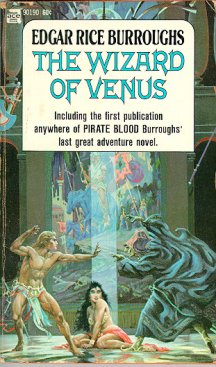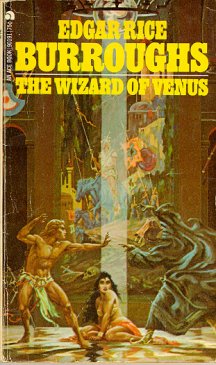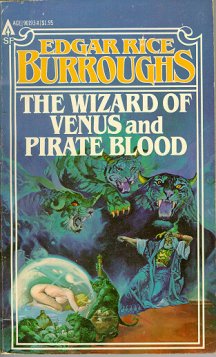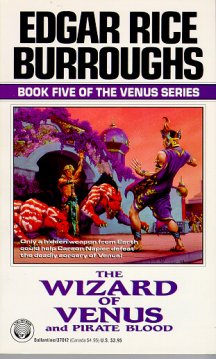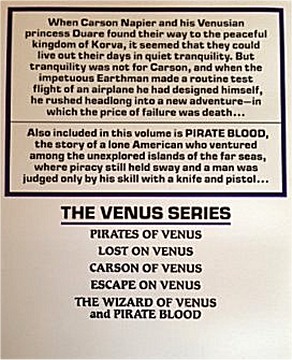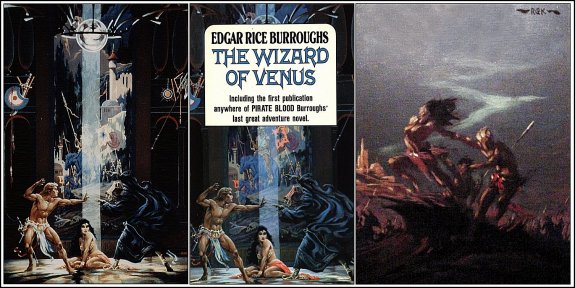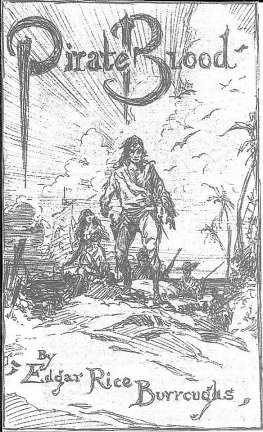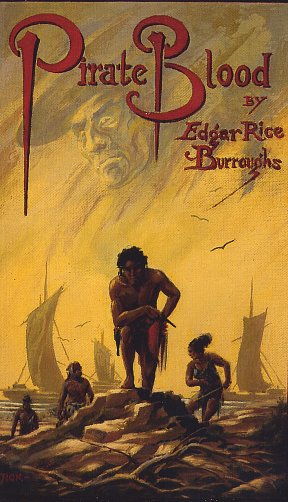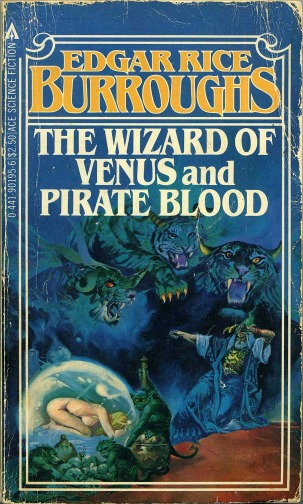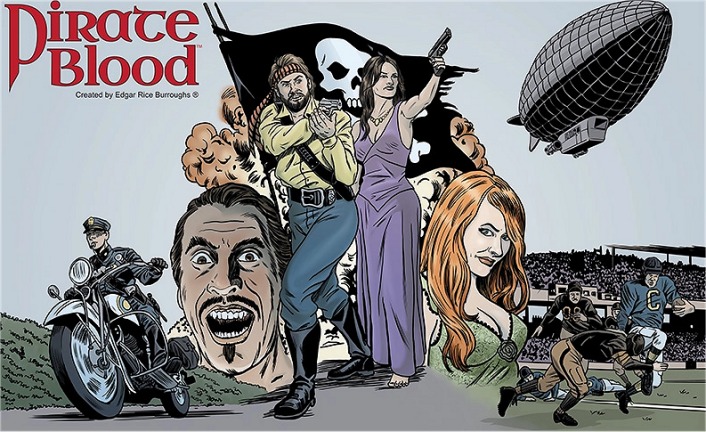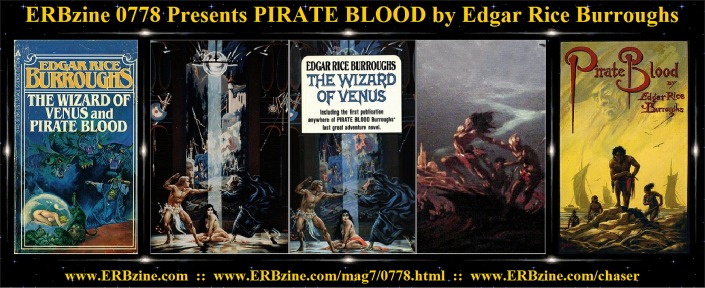Decay of a Second Banana
A
Review by John Martin
John Lafitte – a descendant of pirate Jean Lafitte
-- is the main character in “Pirate
Blood.” But he is not the hero.
There is no hero in this story, except possibly
Frank Adams, who was the hero of the hometown football team at the start
of this novelette.
But this is not supposed to be a tale of heroes,
winners, or people of high community and moral standards, but rather the
story of a second banana football player who becomes a second banana pirate.
The story, written in 1932, was also something
of an experiment.
The writer, Edgar Rice Burroughs, was already the
famous author of a stable of fine heroic stories of adventure set in exotic
locales such as Africa, the inner world, and the unearthly worlds of the
moon, Mars and, soon, Venus, and several other worlds in between, some
real and some of his own invention.
Reportedly, Burroughs wanted to find out if he
could write a different type of story and sell it under an assumed name.
He found out.
The story was rejected, and Burroughs locked the
manuscript, by “John Tyler McCulloch,” in his safe, the experiment over.
Even decades later, when the story was finally
published as part of the Burroughs boom of the '60s, it was still “rejected,”
in a sense, by being printed in the secondary portion of a paperback book
which featured, as its marquee title, “The Wizard of Venus.” One had to
read the smaller print on the cover to even know that the back section
of the book contained another story: “Pirate Blood.”
It is possible that, by this time, with such things
as on-demand printing available, that someone may have finally published
a book which features “Pirate Blood” as the main, or only, story, complete
with action-packed cover art. I don’t know if anyone has done that or not
and a cursory search of the internet failed to locate one.
However, for at least many, many years, it was
never the lead or sole story in any hard or softcover publication.
So, like its second-banana protagonist, the
story itself has been available only in a second-banana status.
The story is about blood – not the type of blood
shed at the point of pirate swords (although there is plenty of that) –
but blood in the sense of heredity.
ERB liked to use some of his stories to explore
the theme of heredity vs. environment.
His Tarzan inherited and displayed the noble characteristics
of an English lord, despite being reared in the jungle by a band of wild
apes. Noble blood triumphed.
Tarzan’s son, Korak, though, inherited his father’s
aptitude for jungle skills, despite being raised in the environs of a civilized
English estate. The blood of the primal man dominated.
There is at least one Burroughs hero who can compare
to John Lafitte in the scalawag department. That true hero is Billy Byrne,
the title character of “The Mucker,” who could be as intimidating of a
baddie as John Lafitte, but with a marked difference: Byrne started out
as a brute, a product of his environment, but, sparked by the presence
of a decent woman, turned into a genuine good guy, who made up for the
bad he had done. Lafitte, by contrast, started out with every advantage:
A good town to grow up in, athletic abilities, popularity, and a steady
job as a policeman, charged with enforcing the law. Yet, at the first opportunity,
he changed sides, becoming a criminal pirate who shed innocent blood and
thought nothing of it.
One might excuse Lafitte for his initial willingness
to become a pirate. Caught by a band of cutthroats when he parachuted onto
their island from a damaged blimp, Lafitte’s eagerness to join the band
of pirates was probably the only thing that saved his life – at that time.
However, with the pirate captain, The Vulture,
lying ill, Lafitte makes a life-changing decision. When the other pirates
report a motorized schooner has put into the island’s small harbor, he
seizes the opportunity to take five men and commandeer the ship.
As the attackers board the vessel, they are outnumbered
in people, but not in weapons and so, the superior weaponry prevailed.
But, with one of the five pirates already shot dead by a yachtsman, Lafitte
could have turned with his own weapon and killed a couple of his fellow
pirates, thus giving those aboard the ship the opportunity to join him
in turning things around. He could have started an action that might have
resulted in the pirates being defeated, and thus won his way back to civilization
and his police officer’s job.
As it is, even though this is fiction, it is unsettling
to read of these 12 yachtsmen and their crew who were so summarily and
thoughtlessly executed and disposed of. It does, however, give a good picture
of what being a pirate really means!
Byrne, having earned the right to be second banana
to The Vulture, participates in other raids where murder, likewise, is
committed.
Eventually, due to Lafitte’s interest in the affection
of The Vulture’s woman, known as La Diablesa (the devil, the witch), he
falls out of favor and is about to be killed when he seizes an opportune
moment to abdicate to a rival band of pirates, commanded by a brigand known
as the Portuguese. Before long, Lafitte earns his way to second banana
status there, as well. He betrays his former crew (no honor among thieves),
leading the Portuguese and his men to a successful surprise attack on The
Vulture’s island compound.
The Portuguese is killed by one of his own men,
leaving Lafitte to become, at last, the top banana. But we do not get to
read of his exploits as such, for the story comes to a quick end after
that. We learn that he winds up in Paris with La Diablese as his wife.
And, as a married man, he no doubt reverts to second banana status once
more!
RANDOM THOUGHTS:
Blood: The story wasn’t only about the
blood-line of Lafitte the pirate (our “hero” being descended from pirate
Jean Lafitte), but also the blood of Lafitte’s “girl of his dreams,” the
hometown beauty named Daisy Juke whom he never had the courage to ask for
a date. Her ancestor was said to be the notorious real-life ne’er-do-well
Max Juke. Through various circumstances, Dasiy also ends up in a position
to be captured by the Portuguese’s pirate band, and comes to an ignominous
end.
Pacing: The first half of “Pirate
Blood” is too long; the second half is too short. Yes, it is true that
ERB had to come up with a plausible way of getting John Lafitte from Southern
California to a pirate island thousands of miles across the Pacific, but
why did that ill-fated balloon ride have to take five chapters? Fewer would
have been better. Or, perhaps ERB should have sent him on a short ride
to the southeast, where he could have ended up as a Pirate of the Caribbean
like his infamous ancestor!
Still, there were some edge-of-seat moments that
showed up in those chapters, particularly the part that had Lafitte barely
hanging on, leaning out of the gondola, undoing stubborn bolts to try to
drop the useless motor so the overburdened airship would rise.
Davis of the L.A.P.D.: In Chapter 9, Lafitte
says, “Since joining the police force I had perfected my work with the
revolver until I could shoot in such company as that of Davis of the Los
Angeles Police Department and not feel ashamed of myself.” Burroughs admired
James E. Davis, who served as chief of the L.A. force twice (1926-1929
and 1933-1939), so no doubt Lafitte’s mention of Davis is intended as a
reference to this man. Burroughs spoke well of Davis in an article he wrote
for a 1929 edition of “The Police Reporter.”
Read article here: www.erbzine.com/mag2/0256.html
or beginning at page 221 of “Edgar Rice Burroughs Tells All,” compiled
by Jerry L. Schneider, available in hardback or paperback at: www.erbvillepress.com
The L.A.P.D. had been plagued by corruption (with
people like Lafitte in it, no wonder!). But Davis was a reformer. Wikipedia.com
says: “In his first term he fired almost a fifth of the force for that
conduct and instituted extensive firearms training and also the dragnet
system). In his second term, Davis instituted a “Red Squad” to attack Communists
and their offices.”
Notable quotables:
As usual, ERB sprinkles his stories with clever
bits of writing. Some examples:
“I thought I would swear, but as there
was no one to hear me, it didn’t seem worth the effort. It is remarkable
how many of our reactions are dependent upon an audience.” – Chapter 6,
while dealing with the foundering blimp.
“Her figure was divine. The combination may best
be described as body by Fischer, bearings by Timkim.” – Chapter 8, a description
of La Diablesa.
“I have killed men, but I have never sent their
widows large bills for my operations. I have robbed people of their all,
but I have mercifully put them out of their misery that
they might not live to bemoan their losses or suffer
the deprivations and reproaches of poverty. In my own way, I too am a philanthropist
and a benefactor of the human race.” – Chapter 10, a sardonic putdown of
worldly do-gooders in an attempt to justify one’s wrongful actions.
“The test of true friendship is the secret sacrifice
that one would make for a friend where no reciprocation of any applause
were possible.” – Chapter 13, while musing on the company he keeps.

